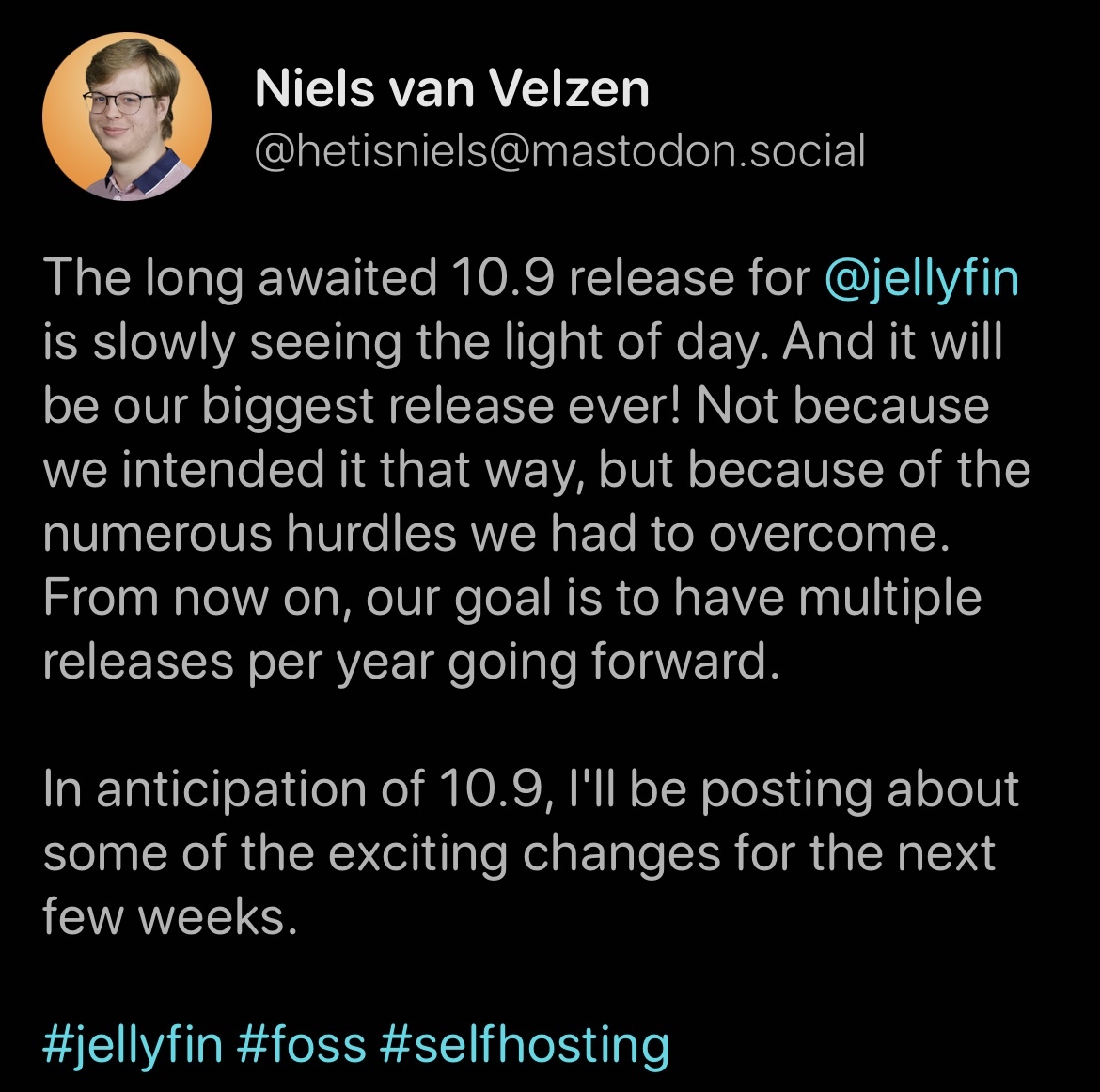this post was submitted on 05 Mar 2024
772 points (99.1% liked)
Jellyfin: The Free Software Media System
5778 readers
14 users here now
Current stable release: 10.10.3
Matrix (General Information & Help)
Matrix (Off-Topic) - Come get to know the team and blow off steam!
Matrix Space - List of all the available rooms on Matrix.
Discord - Bridged to our Matrix rooms
founded 4 years ago
MODERATORS
you are viewing a single comment's thread
view the rest of the comments
view the rest of the comments

Jellyfin is 90% plex, and it's impressive how it comes forward in leaps and bounds, but it's not better than plex. People just appreciate it more.
If you only need that 90% that it does (and don't need things like intro detection, conversions, mobile sync, ass/sas subtitles), then you'll come away super happy with not having to pay plex and not being locked into plex.
It doesn't really do much over that 90%, it's just neat that the 90% isn't plex
Now that's the realistic answer I was looking for, thanks! Open source is really the only reason I want to switch. I bought the lifetime Plex pass like a decade ago so the cost doesn't bother me. The lack of mobile sync is a bummer though
You can run both, since you have Plex paid for anyway. Then you get the best of both worlds, and can maybe get new users on the jellyfin. If they catch that last 10% difference or Plex goes to shit, and jellyfin is a platform you like since you’ll have low-stakes experience with it, maybe you’ll eventually want to move everyone over.
Plus if one service goes down the other may still be up which is nice.
I could ddg this, but how does the remote access work? Do I need to open ports out of my home to have users watch stuff?
I have remote access for Jellyfin using a domain I purchased just for self-hosting. Using Nginx Proxy Manager (NPM) and a dynamic IP service. NPM handles directing the incoming traffic to the correct server. I point a subdomain back to my Jellyfin server. When traveling, I install the Jellyfin app on a smart TV where I am staying, or connect my laptop to the TV and just use the web interface and my subdomain. I also use the Jellyfin android app to connect remotely using a phone or tablet.
At home all my TVs use a Roku and the Jellyfin Roku app to connect locally.
Almost none of this made sense to me, honestly…
I want to use Jellyfin because of its awesome open source and how much effort the devs obviously put into it, but when I use Plex (lifetime pass for $80 back in 2020) I don’t have to do any of this crazy looking text you’ve typed here. I sign into my account, and it’s off to the races.
So, with that being said, for the people in the back like me who this may look like the most complicated stuff in the world just to get some streaming started, are there ANY easy methods to achieve this such as with Plex?
Short answer no.
Plex works by having a centralised server run by Plex themselves, that facilitates your client connecting to your server.
The external facing part of Jellyfin server is basically a web server, and it's a bad idea to expose that to the internet without putting a reverse proxy in front of it (hence the mention of NGINX above).
Another option is to have a VPN connection to where you are running Jellyfin and then only access Jellyfin pseudo locally (so potential security problems aren't a big concern). This introduces other complications if you want to access it remotely via things like Roku or Chromecast, especially if you have multiple external (and probably not tech savvy) users.
I want to stress that none of this is prohibitively expensive or hard, but doing it involves learning and effort.
All the information and programs you need are available online for free.
If you only wanted to use Jellyfin at home (server in the cupboard, client on the tv), none of this other stuff matters. If you want to access Jellyfin remotely, and the idea of running a reverse proxy or a vpn server with the corresponding exposed ports and domain configuration sounds scary, Jellyfin is probably not for you.
That is unfortunate. Thank you for the in depth explanation for those of us on Lemmy who don’t know all there is to know about Linux/CLI/Networking!
I’m the only one who uses my Plex, so the real issue is that I don’t want to fiddle around with settings, proxies, or VPNs just to stream an audiobook through my phone while driving to work. Maybe in the future there will be a more simple self host setup for people like me. I’ll keep an eye on it to see how it progresses. Thanks again! 😁
This is what I do as well, though I also do have tailscale set up on my network as well so that's also an option.
Do you know if there's a good guide for setting that all up? I know all those words but I get nervous about trying to implement them all individually on my own.